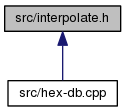 |
Hex
1.0
Hydrogen-electron collision solver
|
All Data Structures Namespaces Files Functions Variables Typedefs Enumerations Enumerator Macros Pages
 |
Hex
1.0
Hydrogen-electron collision solver
|


Go to the source code of this file.
Functions | |
| template<typename T > | |
| NumberArray< T > | interpolate (rArray const &x0, NumberArray< T > const &y0, rArray const &x) |
| Return linearly interpolated values. More... | |
| rArray | interpolate_real (rArray const &x0, rArray const &y0, rArray const &x, const gsl_interp_type *interpolation) |
| Return values interpolated by O₂scl. More... | |
| NumberArray<T> interpolate | ( | rArray const & | x0, |
| NumberArray< T > const & | y0, | ||
| rArray const & | x | ||
| ) |
Returns an array of interpolates of the array y0 for every value of x.
| x0 | X-values for the discrete samples. |
| y0 | Discrete samples |
| x | Evaluation (interpolation) points. |
|
inline |
Returns an array of interpolates of the array y0 for every value of x.
| x0 | X-values for the discrete samples. |
| y0 | Discrete samples |
| x | Evaluation (interpolation) points. |
| interpolation | Interpolation type.
|
 1.8.5
1.8.5